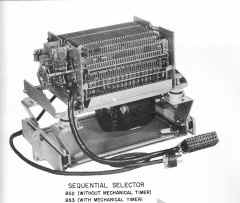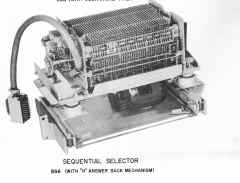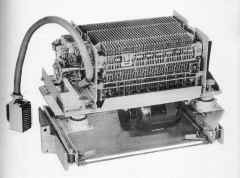


b. The Sequential Selector unit is mounted by resilient fittings to a metal panel which may be secured to a relay rack, a cabinet shelf or a table. The panel also supports the motor and a counter shaft which drives the main shaft of the selector unit. The panel incorporates sliding rails and latches which permit .forward movement of the panel relative to its mounting brackets, which are positioned for standard relay rack spacing.
c. As an adjunct to the contact operating mechanism a mechanical timer is attached to the left, lower rear, side of the Sequential Selector. The timer is geared to the mainshaft through a friction clutch. When it is desirable to introduce a pause in the control sequence, the timer operates in response to a BLANK combination in a transmitter start pattern.
d. The Sequential Selector incorporates an answer back feature which generates an "H" character signal by means of a cam and contact assembly located near the lower, right, rear corner of the unit. When the Sequential Selector at an outlying station receives the transmitter-start pattern signal sequence directing it to start an associated transmitter distributor, the "H" answer back mechanism automatically starts. If there is tape in the transmitter distributor, it will also start and the "H" answer back signal will be shunted out of the signal circuit. If the transmitter distributor is without tape, it will not start. However, the "H" answer back signal will be transmitted over the signal line connected to the transmitter distributor.
e. In order to facilitate orientation of the selector to incoming RY signals, a visual indicator that indicates either accuracy or errors in the translation of signals is provided. This mechanism is disabled during message traffic,
f. In addition to the 33 contacts which may be actuated in response to selecting combinations, a universal contact may be used. This contact is actuated by a bracket attached to the left arm of the stripper bail and responds to each operating cycle of the bail.